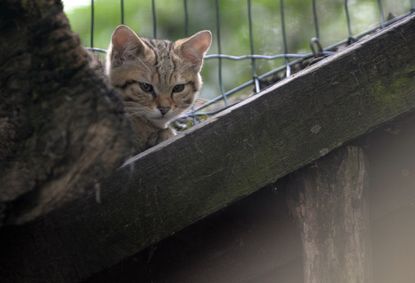Wildcats reconquer Dutch forests
Rewilding of woodlands has encouraged the return of the long-lost feline

Wildcats have been spotted in the Netherlands for the first time in several centuries.
“The return of the animal, with its distinctive round-tipped and black-ringed tail, is a sign of the rewilding of forests in the southern Dutch region of Limburg,” says The Guardian. Wildcats disappeared from the area in the middle ages, due to hunting and forest clearance.
Hettie Meertens, a biologist who works for the ARK conservation group, said the cats would benefit from changing forest management, which now favours nature over wood harvesting. This leads to wilder forests, with fallen trees and hollow spaces that offer wildcats places to rest.
Subscribe to The Week
Escape your echo chamber. Get the facts behind the news, plus analysis from multiple perspectives.

Sign up for The Week's Free Newsletters
From our morning news briefing to a weekly Good News Newsletter, get the best of The Week delivered directly to your inbox.
From our morning news briefing to a weekly Good News Newsletter, get the best of The Week delivered directly to your inbox.
Conservationists have also been encouraging farmers to plant “cat-kind” hedges in their fields to provide habitat for voles, the wildcats’ natural prey.
“The population is small but it is increasing,” said Meertens, and conservationists are confident that they will soon be seen over a much wider area.
ARK plans to count the number of wildcats next year. This task will involve smearing valerian oil, a scent that attracts the cats, on to the branches of trees to encourage them to linger under the lenses of cameras.
The wildcat was once endemic across Eurasia and Africa, says Nature World News. It has longer legs and a flatter head than its domestic cousin.
Sign up for Today's Best Articles in your inbox
A free daily email with the biggest news stories of the day – and the best features from TheWeek.com
It has been extinct in England for more than 200 years, and although “a population of about 300 wildcats remains in Scotland”, says the BBC, “it has been called ‘functionally extinct’ due to interbreeding with domestic cats”.
A wildlife charity, the Wildwood Trust, is hoping to re-establish the species in the UK within the next few years.
Create an account with the same email registered to your subscription to unlock access.
-
 Fallout: one of the 'most faithful – and best – video game adaptations'
Fallout: one of the 'most faithful – and best – video game adaptations'The Week Recommends This 'genre-bending' new Amazon series is set in a post-apocalyptic wilderness where survivors shelter below ground
By Adrienne Wyper, The Week UK Published
-
 'Test of faith for Trump Media's investors'
'Test of faith for Trump Media's investors'Today's Newspapers A roundup of the headlines from the US front pages
By The Week Staff Published
-
 Will Iran attack hinder support for Ukraine?
Will Iran attack hinder support for Ukraine?Today's Big Question Pro-Kyiv allies cry 'hypocrisy' and 'double standards' even as the US readies new support package
By Elliott Goat, The Week UK Published
-
 How the EU undermines its climate goals with animal farming subsidies
How the EU undermines its climate goals with animal farming subsidiesUnder the radar Bloc's agricultural policy incentivises carbon-intensive animal farming over growing crops, despite aims to be carbon-neutral
By Harriet Marsden, The Week UK Published
-
 Chimpanzees are dying of human diseases
Chimpanzees are dying of human diseasesUnder the radar Great apes are vulnerable to human pathogens thanks to genetic similarity, increased contact and no immunity
By Harriet Marsden, The Week UK Published
-
 Can the world really wean itself off coal?
Can the world really wean itself off coal?Today's Big Question 'Record' global consumption is set to fall soon but growing demand in China and India could increase tensions
By Harriet Marsden, The Week UK Published
-
 The microplastics hurricanes blowing across North America
The microplastics hurricanes blowing across North AmericaUnder the Radar New research confirms global pervasiveness of harmful microplastic pollution
By The Week Staff Published
-
 What can Cop28 really achieve?
What can Cop28 really achieve?Today's Big Question Climate summit in UAE proves controversial as UN warns world is falling short of global warming targets
By The Week UK Published
-
 A23a: why world's biggest iceberg is on the move
A23a: why world's biggest iceberg is on the moveThe Explainer The mass of ice is four times the size of New York and 'essentially' an island
By Chas Newkey-Burden, The Week UK Published
-
 Libya floods: death toll set to rise with 10,000 reported missing
Libya floods: death toll set to rise with 10,000 reported missingMore than 6,000 people reported dead, with hundreds of bodies still washing ashore
By Arion McNicoll Published
-
 Thousands feared dead in catastrophic Libya flooding
Thousands feared dead in catastrophic Libya floodingSpeed Read A powerful Mediterranean storm pummeled Libya's northeast coast, wiping out entire neighborhoods
By Peter Weber Published